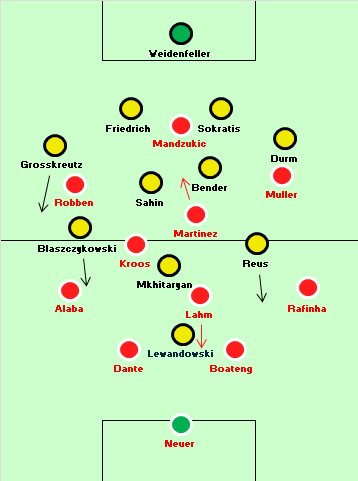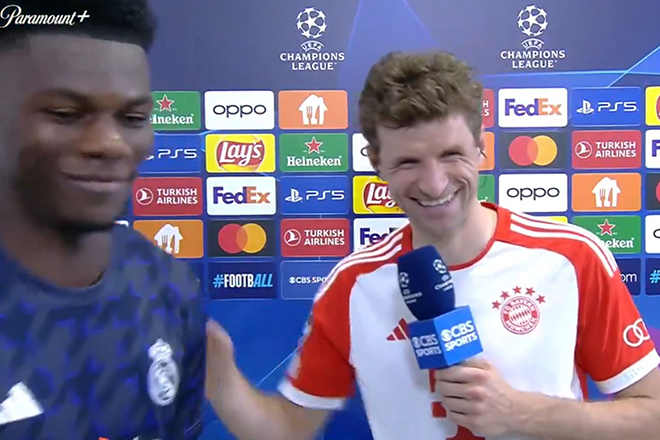 As Mario Gomez missed yet another chance against Real Madrid, Jupp Heynckes reenacted the scene on the touchline. His successor, Pep Guardiola, would have perhaps remained rooted to the ground in the epic semi final between Bayern and Real Madrid in 2012.
As Mario Gomez missed yet another chance against Real Madrid, Jupp Heynckes reenacted the scene on the touchline. His successor, Pep Guardiola, would have perhaps remained rooted to the ground in the epic semi final between Bayern and Real Madrid in 2012.
Heynckes was the fatherly figure who every player liked. He rebuilt a team that was disheartened following two emotionally treacherous campaigns, 2010-11 and 2011-12. He won them all he could and he head back to his green past, Mönchengladbach. Pep Guardiola came in, looking to turn away the skeptics on the first day, as he spoke in German in his press conference.
The season started turbulently but gradually things changed. Today, we have a look at some of the formations Pep has used this season.
4-1-4-1
Bayern relied on two defensive midfielders between 2009-10 and 2012-13. Pep believed that his team could be improved by using a single pivot - his aim, after all, was to retain possession and not play in the manner in which Jupp Heynckes’ side did. Heynckes’ game to game tactical adjustments were obvious and easy on the eye; Pep’s ones are not so obvious. Guardiola’s belief in the single pivot was put to the test and exposed to harsh realities when his side faced Borussia Dortmund in the German Supercup and lost, 4-2. This was also because Thiago Alcantara did not manage to handle the game as a single pivot.
Guardiola stuck with the 4-1-4-1 but adjusted it to resemble somewhat a 4-5-1. He put a defensive minded player in the hole of the “single pivot”, Philipp Lahm, partly because of injuries as well. He could have used Bayern’s bulldozer, Javi Martinez, in that position but he seems to see Martinez as a central defender.
Eventually, this system with Lahm as a single pivot paid its dividends; in their first serious test of the season outside the Bundesliga, Bayern beat Manchester City by playing Lahm in that position. Hence, let us speak a bit more about Philipp Lahm’s conversion into a midfielder quite late into his career.

Philipp Lahm as the Single Pivot
Lahm had seen it all, he had a UEFA Champions League winners medal and had already featured in a European Championship final and two World Cup semi finals before Guardiola had come in. He is 30 years old and is the captain of both club and country. Furthermore, he happens to be one of the best fullbacks in the world if not the best. While every coach Lahm has featured under has felt at one point that he could excel as a midfielder, nobody placed him there due to his abilities as a defender.
Lahm is obviously not the best header of the ball; however, he is adept at stealing the ball from an opponent without tackling him. He is a great asset in attack as he overlaps with the winger plenty of times. Also, he can hit decent crosses into the box. Bayern has never quite had a midfield crisis which has really required the shift of Lahm into midfield.
Pep Guardiola, in the midst of an injury crisis, became the first coach to bravely move Lahm into defensive midfield and use Rafinha, the equivalent of a less refined and ill tempered version of Lahm, into defense. The move paid off and is continuing to pay off so late into the season.
Javier Martinez as a Center-back
This change has not worked out as well as Pep would have hoped. Guardiola seems to view Bayern’s personal bulldozer in midfield as nothing more than a central defender. Martinez has often been found wanting in that position but Guardiola does not seem to see the positives which Jupp Heynckes and almost every fan saw in using Martinez in midfield.
Considering Pep learned a few tricks from Marcelo Bielsa and that Martinez was used in defense by Bielsa, this move is slightly less surprising than it seems. Heynckes also used Martinez at the heart of the back four sometimes but when it came to important matches, he would always move to midfield next to Bastian Schweinsteiger. While he does possess good vision, Schweinsteiger, Lahm and Toni Kroos are more expert midfielders than him; thus, Guardiola prefers them as single pivots.
3-5-2 and the False Fullback
Against Manchester United, Bayern failed to get going but a part of this might have been down to this strange formation by Guardiola. On paper, the team set up as a 4-1-4-1. When in attack, Toni Kroos, the single pivot, pushed back into defense as Philipp Lahm and David Alaba moved infield. This made Bayern appear a bit narrow; they lacked the width to really give United trouble. In the second half, Lahm was permanently moved into midfield and Kroos pushed a bit further up; the move bore fruit as Bayern went on to score three goals to win the tie.

Toni Kroos as the Single Pivot
Kroos has seen plenty of criticism in his career for his lack of defensive abilities. Last season, under Heynckes, he took a massive step in improving his defensive skills. This season, Guardiola has handed him huge defensive responsibilities, including playing him as a single pivot. While this reduces Kroos’ impact as a playmaker, it helps improve his overall abilities. Largely, the move has not been seen as a bad one and has even been appreciated by the man who really oversaw the German’s development, Heynckes.
4-4-2
On the odd occasion, Guardiola has decided to use two strikers up front in Claudio Pizarro and Mario Mandzukic. Sometimes, this approach has paid dividends. Pizarro is as pure a striker as they come; his experience at 35 years of age also helps his cause despite the fact that his speed is diminishing. He is indeed a Bayern veteran and looks happy to play whenever he is on the pitch. Mandzukic has a point to prove seemingly as Robert Lewandowski will be competing for what is currently his spot next season. The striker is also vying for the Bundesliga’s top scoring crown with the Pole.
Which formation will Guardiola use against Real Madrid? Let us know your thoughts below!
(All tactical images courtesy of zonalmarking.net)




























